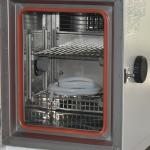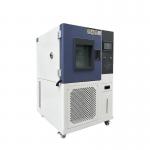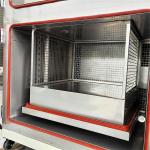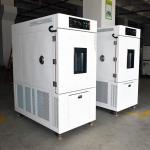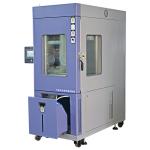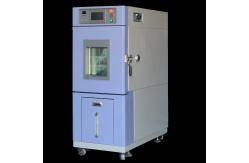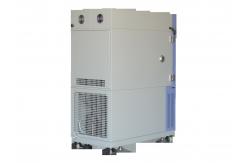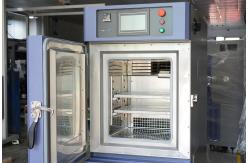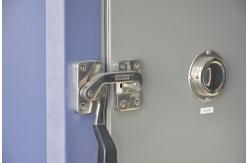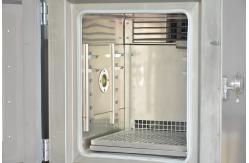Textile fabrics are used in a wide variety of applications, from
clothing and home furnishings to industrial and technical textiles.
The quality, performance, and durability of textile fabrics are
significantly influenced by environmental factors, especially
temperature and humidity. To accurately assess and improve the
characteristics of textile fabrics, a programmable constant
temperature and humidity controlled chamber is an indispensable
tool. This specialized chamber allows textile manufacturers,
researchers, and quality control professionals to subject fabrics
to precisely controlled environmental conditions, simulate real -
world scenarios, and conduct in - depth testing and analysis.
The most distinctive feature of this chamber is its high - level
programmability. Users can create highly customized temperature and
humidity profiles to mimic a wide range of real - world
environments that textile fabrics may encounter. The temperature
can be precisely adjusted within a broad range, typically from
-70°C to 150°C, while humidity levels can be set from 10% to 95%
relative humidity (RH). Whether it's simulating the dry heat of a
desert climate or the damp humidity of a tropical rainforest, the
chamber can replicate these conditions with great accuracy. The
programming options include cyclic testing, where temperature and
humidity change in a repeating pattern, step - by - step testing
for gradual transitions, and long - term steady - state testing to
evaluate fabric performance over extended periods.
Ensuring uniform temperature and humidity distribution throughout
the chamber is crucial for accurate fabric testing. The chamber is
designed with advanced air circulation systems that evenly
distribute the conditioned air, minimizing any hot or cold spots
and ensuring consistent humidity levels. This uniform distribution
is vital as it allows for reliable testing of fabric samples,
eliminating any variations in test results due to uneven
environmental exposure. As a result, the data collected from the
tests is more representative of the fabric's true performance under
specific conditions.
The chamber features a spacious interior designed to accommodate a
significant amount of textile fabric samples. Whether it's a small
- scale research project with a few fabric swatches or a large -
scale quality control test of rolls of fabric, the chamber has
sufficient space. The interior layout is flexible, with adjustable
shelves and holders that can be configured to suit different fabric
sizes and testing requirements. This large - capacity design
enables efficient testing, allowing multiple samples to be tested
simultaneously, saving both time and resources.
A comprehensive monitoring and data logging system is integrated
into the chamber. Multiple sensors are strategically placed to
continuously monitor temperature, humidity, and other relevant
parameters such as air pressure and fabric - related measurements
(if applicable). The data is logged at high frequencies, providing
a detailed and continuous record of the fabric's environmental
exposure during the test. The data can be accessed in real - time
through a user - friendly interface, and historical data can be
retrieved for in - depth analysis. This wealth of data helps in
understanding how textile fabrics respond to different
environmental conditions over time, facilitating the identification
of trends and potential areas for improvement.
Built to withstand the rigors of continuous use in a textile
testing environment, the chamber is constructed using high -
quality, durable materials. The exterior is made of corrosion -
resistant steel, providing excellent protection against physical
damage and environmental factors. The interior is lined with
materials that are resistant to heat, moisture, and chemicals,
ensuring a long - lasting and stable testing environment. The
components of the temperature and humidity control systems are also
selected for their reliability and durability, minimizing the need
for frequent maintenance and breakdowns.
Safety is a top priority in the design of the chamber. It is
equipped with a range of safety features to protect both the fabric
samples and the operators. Over - temperature and over - humidity
protection systems are in place to prevent any abnormal increases
in these parameters, which could potentially damage the fabric or
the chamber itself. Fire suppression systems are installed to
address any potential fire hazards, and emergency stop buttons are
located conveniently throughout the chamber for immediate shutdown
in case of an emergency.
| Model | THC-225 | THC-408 | THC-800 | THC-1000 |
| Inside dimension(W x D x H) mm | 50 x 75 x 60 | 60 x 85 x 80 | 100 x 100 x 80 | 100 x 100 x 100 |
| Outside dimension(W x D x H) mm | 75 x 165 x 170 | 85 x 175 x 190 | 125 x 190 x 190 | 125 x 190 x 210 |
| Internal material | #304 Stainless Steel |
| External material | Powder coated #304 Stainless Steel |
| Temperature range | + 150℃~ - 70 ℃ |
| Humidity range | 5% ~ 98% R. H |
| Temperature resolution ℃ | 0.01 |
| Humidity resolution % R. H. | 0.1 |
| Temperature stability ℃ | ±0.3 |
| Humidity stability % R. H. | ±2 |
| High temperature ℃ | 100 | 100 | 100 | 100 |
| Heating time (min) | 20 | 30 | 30 | 30 |
| Low temperature | 0, -40, -70 | 0, -40, -70 | 0, -40, -70 | 0, -40, -70 |
| Cooling time (min) | 20, 50, 70 | 20, 50, 70 | 20, 50, 70 | 20, 50, 70 |
| Air circulation system | Mechanical convection system |
| Cooling system | Imported compressor, fin evaporator, gas condenser |
| Heating system | Sus304 Stainless steel High-speed heater |
| Humidification system | Steam Generator |
| Humidification water supply | Reservoir, Sensor-controller solenoid valve, recovery-recycle
system |
| Controller | Touch panel |
| Electrical power requirements | Please contact us for requirements of specific models |
| Safety device | Circuit system load protection, compressor load protection, control
system load protection, humidifier load protection, overtemperature
load protection, fault warning light |
By subjecting textile fabrics to precisely controlled temperature
and humidity conditions, manufacturers can identify and address
potential quality issues early in the production process. This
allows for the optimization of fabric manufacturing processes, such
as spinning, weaving, and dyeing, to ensur
